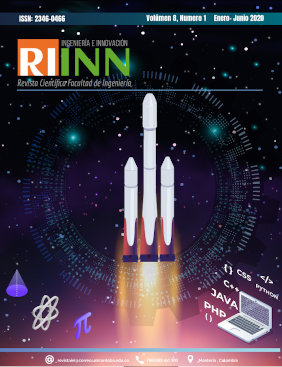Mostrar biografía de los autores
The interaction with context has undergone major transformations over time, all thanks to advances in nanotechnology that have facilitated the creation of much more robust hardware in terms of processing capacity, storage and high-speed telecommunications systems. Allowing a migration from explicit interactions that were only limited to navigation interfaces between the user and the devices to other types of interactions (implicit and peripheral).
Visitas del artículo 322 | Visitas PDF
Descargas
Weiser, M., & Brown, J. S. (1997). The coming age of calm technology. In Beyond calculation (pp. 75-85). Springer, New York, NY.
Pousman, Z., & Stasko, J. (2006, May). A taxonomy of ambient information systems: four patterns of design. In Proceedings of the working conference on Advanced visual interfaces (pp. 67-74).
Eggen, B., & Van Mensvoort, K. (2009). Making sense of what is going on ‘around’: designing environmental awareness information displays. In Awareness Systems (pp. 99-124). Springer, London.
Bakker, S., van den Hoven, E., & Eggen, B. (2015). Peripheral interaction: characteristics and considerations. Personal and Ubiquitous Computing, 19(1), 239-254.
Schmidt, B. (2000). The modelling of human behaviour: The PECS reference models. Delft: SCS-Europe BVBA.
Dey A., Abowd G., (1999). Towards a Better Understanding of context and context awareness. Georgia Institute of Technology, College of Computing.
Ogata, H., Akamatsu, R., & Yano, Y. (2005). Computer supported ubiquitous learning environment for vocabulary learning using RFID tags. In Technology enhanced learning (pp. 121-130). Springer US.
Yin, C., Ogata, H., Tabata, Y., & Yano, Y. (2010). Supporting the acquisition of Japanese polite expressions in context-aware ubiquitous learning. International Journal of Mobile Learning and Organisation, 4(2), 214-234.
Goh, T. T., Seet, B. C., & Chen, N. S. (2012). The impact of persuasive SMS on students' self‐regulated learning. British Journal of Educational Technology, 43 (4), 624-640.
Tsai, C. H., & Huang, J. Y. (2014, August). A mobile augmented reality based scaffolding platform for outdoor fieldtrip learning. In Advanced Applied Informatics (IIAIAAI), 2014 IIAI 3rd International Conference on (pp. 307-312). IEEE.
Yang, S. J. H. (2006). Context aware ubiquitous learning environments for peer-to-peer collaborative learning. Educational Technology and Society, 9, 188–201.
Liu, G. Z., Kuo, F. R., Shi, Y. R., & Chen, Y. W. (2015). Dedicated design and usability of a context-aware ubiquitous learning environment for developing receptive language skills: a case study. International Journal of Mobile Learning and Organisation, 9(1), 49-65.
Hsu, T. Y., Chiou, C. K., Tseng, J. C., & Hwang, G. J. (2016). Development and evaluation of an active learning support system for context-aware ubiquitous learning. IEEE Transactions on Learning Technologies, 9(1), 37-45.
Huang, Y. M., & Chiu, P. S. (2015). The effectiveness of a meaningful learning‐based evaluation model for context‐aware mobile learning. British Journal of Educational Technology, 46(2), 437-447.
Zimmerman, B. J. (1998). Academic studying and the development of personal skill: A selfregulatory perspective. Educ. Psychol. 33: 73–86.
Hou, B., Ogata, H., Miyata, M., Li, M., & Liu, Y. (2010). JAMIOLAS 3.0: Supporting Japanese mimicry and onomatopoeia learning using sensor data. International Journal of Mobile and Blended Learning (IJMBL), 2(1), 40-54.
Chen, C. M., & Li, Y. L. (2010). Personalised context-aware ubiquitous learning system for supporting effective English vocabulary learning. Interactive Learning Environments, 18(4), 341-364.
Jones, V., & Jo, J. H. (2004, December). Ubiquitous learning environment: An adaptive teaching system using ubiquitous technology. In Beyond the comfort zone: Proceedings of the 21st ASCILITE Conference (Vol. 468, p. 474).
Liu, T. Y., Tan, T. H., & Chu, Y. L. (2009). Outdoor Natural Science Learning with an RFID-Supported Immersive Ubiquitous Learning Environment. Educational Technology & Society, 12(4), 161-175.
Tan, T. H., Liu, T. Y., & Chang, C. C. (2007). Development and evaluation of an RFID-based ubiquitous learning environment for outdoor learning. Interactive Learning Environments, 15(3), 253-269.
Liu, T. Y., Tan, T. H., & Chu, Y. L. (2009). Outdoor Natural Science Learning with an RFID-Supported Immersive Ubiquitous Learning Environment. Educational Technology & Society, 12(4), 161-175.
Gómez, J. E., Huete, J. F., & Hernandez, V. L. (2016). A contextualized system for supporting active learning. IEEE Transactions on Learning Technologies, 9(2), 196-202.
Zhou, J. (2010). Context-aware pervasive service composition, Intelligent Systems, Modelling and Simulation (ISMS), International Conference on Liverpool.
Siekkinen, M., Hiienkari, M., Nurminen, J. K., & Nieminen, J. (2012, April). How low energy is bluetooth low energy? comparative measurements with zigbee/802.15. 4. In 2012 IEEE wireless communications and networking conference workshops (WCNCW) (pp. 232-237). IEEE.





